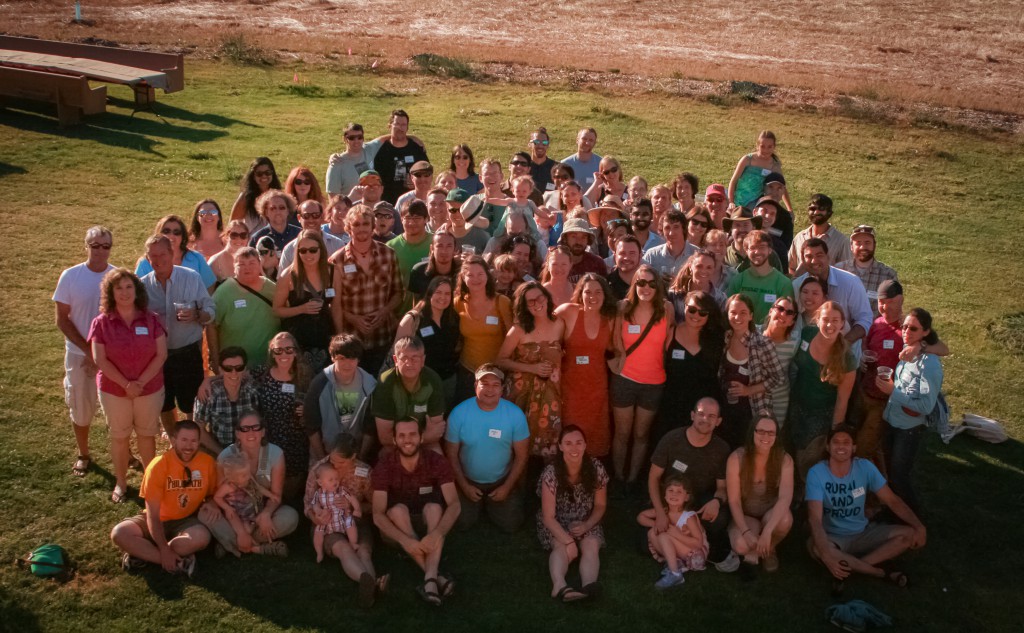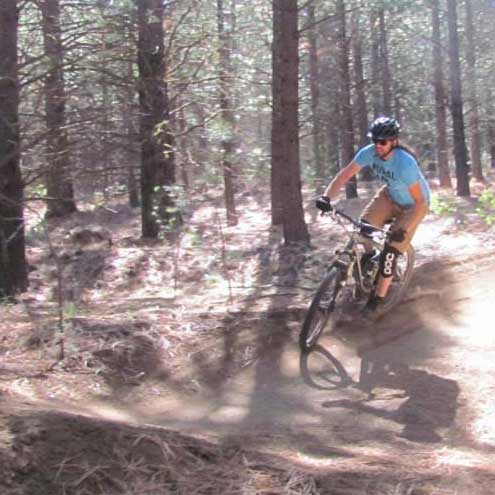By Emme Shoup, Assistant Community Engagement and Program Coordinator, City of Sisters

Walking into my RARE AmeriCorps placement in Sisters, Oregon as the Assistant Community Engagement and Program Coordinator for City Hall, I knew my job was not going to be easy. Not only was I entirely new to the community and didn’t know anyone, but I would have to work extra hard to make connections and learn about the intricacies of the community in a time when everything was socially-distanced.
Sisters, Oregon, a rapidly-growing small town of 3,000 residents is known to be a vibrant, western-themed town that attracts tourists, outdoor recreation enthusiasts, artists, retirees, and more recently wealthy households who are able to work completely remotely. Sisters is famous for its arts scene and community events such as the Sisters Folk Festival, the Sisters Outdoor Quilt Show, the Sisters Rodeo, and the Harvest Festival. As a result of the COVID-19 pandemic and the Santiam Pass wildfires, virtually all community events were disrupted. Coming into Sisters at such a time, it was hard to not feel left out when locals would tell me about how much I was missing out on in a normal year.
However, I was not going to let myself feel despaired. I came to this community to serve and to find ways to bring people together, despite regulations that kept us physically apart.
One of the main projects I had been assigned to is the Sisters 2040 Comprehensive Plan Update. A comprehensive plan is the long-range plan for how a town will grow and develop. For a small town with a population of less than 10,000 residents, Oregon State only encourages that they review their comprehensive plan document periodically (about every 15 years), but it is not required. However, for Sisters, the town has changed a lot in the past 15 years. Since the last Comprehensive Plan Update in 2005:
- The population has doubled from approximately 1600 residents to around 3000 residents.
- The town continues to see a strong tourism sector that necessitates maintaining the balance of local livability and visitor experiences
- There is a need for a full range of affordable housing options for its residents
- There is a priority placed on access to natural areas
- And a need to accommodate future growth while retaining the qualities that make Sisters the gem that it is
However, one thing has remained the same – traffic continues to worsen.
Though many Sisters residents do not want to encourage growth for several reasons, ignoring the issue by not updating the comprehensive plan will only make things worse.
Creating a strategic plan to accommodate how growth looks and feels in city limits will be integral. In order to do this in the Sisters 2040 Comprehensive Plan Update, community input is a priority. By listening to the community, we can translate today’s cultural values into future policy and code.
So how do you engage the community during COVID-19? Instead of meeting people halfway, like in standard community engagement, the Sisters Comprehensive Plan team has been meeting people where they are – at home, virtually, or on the street.
Here are some examples of how we have been conducting extensive community outreach and engagement during the COVID-19 pandemic:
- Community Conversations:
Call or email pre-existing local boards, organizations, or groups that are already meeting virtually and ask for around 60-90 minutes of their time to facilitate a conversation around your subject. The benefit of this is you are reaching multiple people at once, at a time they already have a scheduled “gathering”, and are encouraging a conversation with a pre-established group that are already comfortable sharing ideas with each other.
The Comprehensive Plan team conducted these meetings via Zoom, at the convenience of the group, shared the discussion questions with the group prior to the meeting, presented a prepared presentation, and facilitated a conversation around the provided questions. As an added “cherry-on-top”, we provided immediate visual validation that the community’s feedback had been received using a Word Cloud program.

- Word Clouds:
Mentimeter, a free, online presentation platform, offers a Word Cloud feature where words can be inputted by a moderator or the audience to identify sentiments and important themes that your presentation audience may have around your topic.
Using Mentimeter where your audience enters their own words in response to the prompt can be time-intensive because your audience will need to take time to learn how to navigate the platform and provide input. This may be fine if you are meeting with the same group multiple times and have extra time to accommodate that process. For the Comprehensive Plan team, we needed to prioritize time on facilitating a meaningful conversation because we typically had less than 60 minutes and every community conversation was with a new group where we couldn’t assume how tech-savvy our audience was. Instead, we assigned a moderator to listen intently to the conversation and input key terms in response to the prompt. Then, at the end of the conversation, when wrapping up the Community Conversation, we shared the Word Clouds over Zoom. Participants always enjoyed seeing the colorful word clouds and better understanding what were the key priorities and themes they had discussed that day. We also emailed all the participants a copy of the Word Cloud after each meeting.
The Word Cloud below is an example pulled from one of the Comprehensive Plan Community Conversations.
- Online Open House Event:
Typically, for a comprehensive plan update such as the Sisters 2040, City Hall would host an in-person Open House event where the community could meet with the team updating the plan, ask questions, and provide direct feedback about various topics and prompts. This type of event would take a few hours to participate in.
During the COVID-19 pandemic, the Comprehensive Plan team still had to find a way to authentically engage the community like an Open House would. Our Open House became an online, interactive StoryMap survey, which in a sense makes Open Houses more accessible than ever. The whole process is streamlined to give the community member all the information they could need in the convenience of their own home! Our Online Open House Survey was live for one month, along with extensive community outreach to advertise and help community members navigate the platform. We also incorporated a raffle into the survey so that participants have a chance to win one of six $25 gift cards to a local grocery store. Who could complain about that? Free food and supporting local businesses!
- Pop-Up Art Installation:
 Sisters has a significant local art culture, so what better way to highlight what makes our community unique by creating a engagement station pop-up! Our Pop-Up art installation took place in the Barclay Park timber archway, which sets in the heart of downtown where many people walk around to different shops throughout the day. Passersby would walk by the archway and see the Sisters 2040 Community Web. The Community Web was made up twine (to reflect the downtown western-theme) and scraps of fabric with notes written on them (fabric because of the local quilting culture). On the installation was an explanation of what the comprehensive plan is, advertised the Online Open House happening at the time, and provided instructions on how to engage with the art installation. Information was also posted in Spanish.
Sisters has a significant local art culture, so what better way to highlight what makes our community unique by creating a engagement station pop-up! Our Pop-Up art installation took place in the Barclay Park timber archway, which sets in the heart of downtown where many people walk around to different shops throughout the day. Passersby would walk by the archway and see the Sisters 2040 Community Web. The Community Web was made up twine (to reflect the downtown western-theme) and scraps of fabric with notes written on them (fabric because of the local quilting culture). On the installation was an explanation of what the comprehensive plan is, advertised the Online Open House happening at the time, and provided instructions on how to engage with the art installation. Information was also posted in Spanish.
 Instructions were: write a note on a scrap of fabric about What Makes Sisters, Sisters? and/or What does Sisters look like to you in 2040?, then tie your piece of fabric to the Sisters2040 Community Web art installation. In the end, the web will be full of colorful pieces of fabric with thoughts and hopes of the future of Sisters. City staff will come visit the art installation daily to see what the community is saying and record your feedback to inform the Comprehensive Plan Update!
Instructions were: write a note on a scrap of fabric about What Makes Sisters, Sisters? and/or What does Sisters look like to you in 2040?, then tie your piece of fabric to the Sisters2040 Community Web art installation. In the end, the web will be full of colorful pieces of fabric with thoughts and hopes of the future of Sisters. City staff will come visit the art installation daily to see what the community is saying and record your feedback to inform the Comprehensive Plan Update!
The purpose of this art installation was to find a way to creatively engage the community to educate about the Comprehensive Plan Update in a non-virtual setting, gather direct public input, and encourage positive community energy. We think our community web was successful in doing that, but there are other similar ways to achieve the same concept – such as a community blackboard.
I hope these community engagement ideas help your team find ways to creatively engage with your community to make meaningful change. You can learn more about the Sisters 2040 Comprehensive Plan Update project here: https://www.sisters2040.com/
 About the author, Emme Shoup: Emme recently graduated Summa Cum Laude from Portland State University with a B.S. in Community Development. While at PSU, she studied abroad in the Peruvian Andes where she got a certification in Permaculture Design. Her studies focused in sustainable land use, public health, and urban design. In the future she hopes to promote public health and community-building through placemaking public spaces. In her free-time, she enjoys being active and making art.
About the author, Emme Shoup: Emme recently graduated Summa Cum Laude from Portland State University with a B.S. in Community Development. While at PSU, she studied abroad in the Peruvian Andes where she got a certification in Permaculture Design. Her studies focused in sustainable land use, public health, and urban design. In the future she hopes to promote public health and community-building through placemaking public spaces. In her free-time, she enjoys being active and making art.




